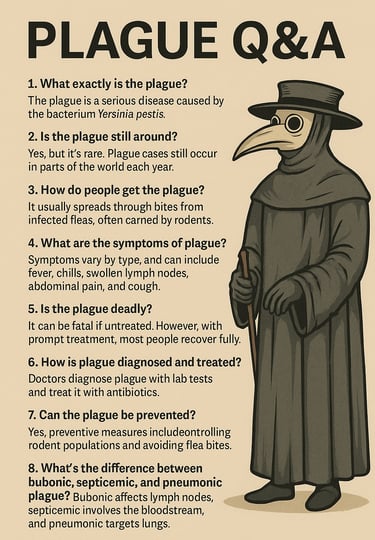Plague Q&A: What You Really Need to Know About This Ancient but Ongoing Disease
Think the plague is a thing of the past? Think again. This Q&A answers your top questions about the plague — from symptoms and types to treatment and modern outbreaks.
DISEASES AND CONDITIONS
Dr. S. Ali
7/12/20255 min read


Introduction
When most people hear the word “plague,” they imagine black-robed doctors with beaked masks and the grim toll of the Black Death. It feels like a horror story from history books — something the modern world left behind. But here’s the truth: plague still exists today.
Yes, the same disease that killed millions in medieval Europe still pops up in parts of the world each year, including the U.S. The difference? Now we understand it — and we know how to treat it.
In this Q&A, we’ll clear up the confusion and explain what plague really is, what causes it, how to recognize it, and why we shouldn’t panic — but still need to stay aware.
1. What exactly is the plague?
The plague is a serious bacterial infection caused by Yersinia pestis. It’s the same bacteria responsible for some of the deadliest pandemics in human history — including the infamous Black Death of the 14th century. Despite its terrifying reputation, today it’s a treatable disease when caught early.
2. Is the plague still around?
Yes, but it’s rare. Plague cases still occur every year, especially in rural parts of Africa, Asia, and even the western United States. In the U.S., it’s most commonly reported in parts of New Mexico, Arizona, Colorado, and California. Don’t worry though — it’s nothing like the medieval outbreaks. Modern medicine makes all the difference.
3. What are the different types of plague?
There are three main types of plague — bubonic, septicemic, and pneumonic — each affecting different parts of the body and varying in severity.
4. What is bubonic plague?
Bubonic plague is the most common form of plague, caused by the bacterium Yersinia pestis. It typically spreads through the bite of an infected flea and leads to painful, swollen lymph nodes called buboes, usually in the groin, armpit, or neck. Other symptoms include fever, chills, weakness, and body aches. Although it was once deadly, bubonic plague can now be effectively treated with antibiotics if caught early.
5. What is pneumonic plague?
Pneumonic plague is a severe and highly contagious form of plague that affects the lungs. It can develop from untreated bubonic or septicemic plague or be transmitted directly from person to person through respiratory droplets. Symptoms include fever, cough, chest pain, difficulty breathing, and sometimes bloody sputum. Pneumonic plague progresses rapidly and can be fatal if not treated quickly with antibiotics, but early medical care usually leads to full recovery.
6. What is septicemic plague?
Septicemic plague is a serious form of plague that occurs when the Yersinia pestis bacteria spread into the bloodstream. It can happen on its own or develop from untreated bubonic plague. This type doesn't always cause swollen lymph nodes but leads to symptoms like high fever, chills, extreme weakness, abdominal pain, bleeding under the skin, and in severe cases, tissue turning black due to lack of blood flow. Without prompt antibiotic treatment, septicemic plague can be life-threatening.
7. What’s the difference between bubonic, septicemic, and pneumonic plague?
Great question. These are three forms of the same disease, depending on where the bacteria travel in the body:
Bubonic plague: affects the lymph nodes. Most common.
Septicemic plague: spreads in the bloodstream. Can happen on its own or follow bubonic plague.
Pneumonic plague: infects the lungs. Most dangerous form and the only one that can be passed person-to-person.
8. How do people get the plague?
Plague is typically spread through bites from infected fleas, often carried by rodents like rats, squirrels, and prairie dogs. You can also catch it through direct contact with infected animals or, in rare cases, by inhaling droplets from someone with a severe lung infection (pneumonic plague). It’s not easily passed from person to person in casual contact.
9. Can you get the plague from another person?
It depends on the type of plague. Pneumonic plague — the form that affects the lungs — can spread from person to person through respiratory droplets when an infected person coughs or sneezes. However, this type of transmission is rare and usually requires close, prolonged contact. Bubonic and septicemic plague do not spread between people under normal circumstances. Most cases come from flea bites or handling infected animals, not human-to-human contact. With proper precautions and quick treatment, the risk of spread is very low.
10. What are the symptoms of plague?
That depends on the type, but early symptoms can show up within 2–6 days of exposure. With bubonic plague (the most common form), people often develop sudden fever, chills, fatigue, and painfully swollen lymph nodes (called “buboes”) — usually in the armpit, groin, or neck. Septicemic plague (when the bacteria enter the bloodstream) can cause abdominal pain, bleeding, and shock, while pneumonic plague affects the lungs, causing cough, chest pain, and shortness of breath. Pneumonic plague is the most serious — and the only one that can spread through respiratory droplets.
11. Is the plague deadly?
It can be — especially if left untreated. Historically, plague killed up to 60% of infected people. Today, with antibiotics and supportive care, most people recover fully if treatment starts early. Without treatment, however, it can still be fatal, especially in its more severe forms.
12. How is plague diagnosed and treated?
Doctors typically use blood tests, lymph node samples, or sputum tests (for pneumonic plague) to confirm infection. Once diagnosed, treatment involves antibiotics — such as doxycycline, ciprofloxacin, or streptomycin. The earlier treatment begins, the better the outcome. Hospitalization is often required, especially for more severe forms.
13. Can the plague be prevented?
Yes, prevention is possible — especially in areas where plague still occurs. Avoiding contact with wild rodents and using insect repellent in high-risk areas can help. If you live in or travel to places where plague is found, don’t feed wild animals or let pets roam unsupervised. Public health authorities also monitor outbreaks and take steps to control the spread through surveillance, flea control, and education.
14. Was the Black Death really the plague?
Yes — most historians agree that the Black Death was caused by Yersinia pestis, although there’s some debate about whether other diseases may have been involved too. Regardless, the symptoms recorded in the 1300s align closely with bubonic and pneumonic plague. What made it so deadly then was the lack of antibiotics, limited medical knowledge, and poor sanitation.
15. Should I be worried about getting the plague today?
In most places, no. The risk is extremely low for the general public — especially if you live outside of plague-endemic regions. But awareness is still important. If you’re hiking or camping in rural areas where plague has been reported, take precautions like using insect repellent and keeping food sealed away from animals. If you work with wildlife or animals in high-risk areas, your doctor might even recommend preventive antibiotics.
Final Thoughts
Plague might sound like a disease from the Dark Ages, but it's still with us — just not in the way people imagine. Thanks to modern science, it's no longer a death sentence. With quick treatment, most people recover fully. Still, it's worth knowing the basics, especially if you live in or travel to areas where the bacteria are still present in wildlife. Knowledge, not panic, is the best protection against the plague — and a reminder of how far medicine has come.
Sources:
Centers for Disease Control and Prevention (CDC) – Plague
https://www.cdc.gov/plague/World Health Organization (WHO) – Plague
https://www.who.int/news-room/fact-sheets/detail/plagueMayo Clinic – Plague
https://www.mayoclinic.org/diseases-conditions/plague/MedlinePlus (U.S. National Library of Medicine) – Plague
https://medlineplus.gov/plague.htmlJohns Hopkins Medicine – Plague
https://www.hopkinsmedicine.org/health/conditions-and-diseases/plague
National Institute of Allergy and Infectious Diseases (NIAID) – Plague
https://www.niaid.nih.gov/diseases-conditions/plague
